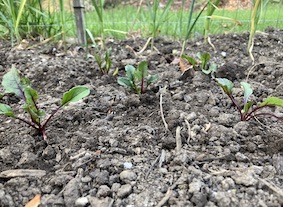Transplanting Beets from Seedlings
Views: 10401

My brother called me in early spring and said, “I am transplanting beets from seed starts this year, in order to get a good early crop.” My response? “It’s not gonna work.” I was adamant. “Not. Going. To. Work.”
Guess how this situation turns out. Exactly. He had an excellent crop of beets. From transplants. I would insert hand-over-face emoji here if I knew how.
Why Transplanting Beets Shouldn’t Work
For years, I’ve been under the impression that crops that have a taproot—vegetables such as carrots, parsnips, turnips, rutabagas and yes, beets—could not be transplanted. Well, they could be transplanted but not with any success. I’d read this in gardening books, on gardening websites and on university agricultural extension sites. Their reasoning for taprooted crops not transplanting well? Because the young root hairs just developing around the still-slim beet (or carrot or parsnip) do not appreciate being disturbed. These root hairs are developing those important bonds with the soil’s biome—the bacteria and fungi that are beneficial to the plant. Disturb those new connections early in the beet’s development and you could cause detrimental harm to the plant. Not good.
How My Brother Had Success With Beets
If all of that is true—that transplanting beets from the soil where their seeds sprouted into a new piece of ground isn’t good for the taproot—then how did my brother have success transplanting beets? Here’s what he did:
• He used a 72-cell tray. This is a plastic seed tray with 72 individual cells. It’s like a 6-pack tray of plants, only bigger.
• He planted one seed per cell. Beet seeds are fairly large, so it’s easy to handle these seeds individually. He planted two trays but didn’t use all of the cells as he didn’t have 144 seeds, more like 110 seeds.
• He germinated these seeds in his greenhouse along with a few trays of other spring crops. He didn’t do anything special, just grew them the same as he did the other crops. And he had pretty good germination, only having a 4 or 5 seeds that didn’t come up.
• He transplanted the beet seedlings when they developed their first set of true leaves (he didn’t say how many days that took). He spaced them 3 inches apart. And he poked a simple hole in the soil, nothing special.
About two months later, my brother pulled the beets to sell at his farm stand. He reports that all of the beets he planted survived and they were all about 1.5 inches in diameter. That’s a decent size! Just the size his farm stand customers like.
I bought my beets as small seedlings planted in a 6-pack, multiple seedlings per cell, so not quite like my brother’s situation as I had to tease their taproots apart. We’ll see how mine turn out. Maybe the term “eating crow” should be “eating beets” for me.
Looking for a new variety of beets to try this transplanting technique on? Read my previous post about Avalanche beets.
Meet Ellen Wells
When you’re raised on a farm, you can’t help but know a thing or two about gardening. Ellen Wells is our expert on edible gardening.…







